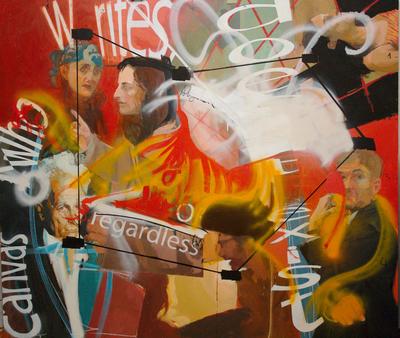- "Der junge Philosoph" (2m x 2m)
- Oil over canvas and spray
- 2014
I will open this reflection about the canvas "Der junge philoshop" speaking about another work of Abel Garces. "Lange nacht der Seele" is a photographic collage Between texts from Gustav Meyrink's Golem and several images about the nightlife in Vienna. A very oppressive and shadowy photographs collection with whom the text relates, reacting to the hovering of the mouse. The way that words relate with images here, although it may seem purposely crafted to produce a kind of symbolic meaning, is nothing but random, and it is deliberately so. Why is then, that this apparent meaningful relation appears? This narrative appears as the spectator assumes almost inevitably that there is an intention behind it. It is probably a very atavistic instinct where we humans, try to see in everything a similar behaviour from ourselves as it could possible be. It is the reason why we see faces on clouds and celestial patterns in the otherwise random events of history.
The observer is always waiting for meaning and in meaning and conscience could be reduced the process of observing.As what consciousness and meaning are and how they work, it is today still a mystery. Two concepts inextricably linked together and the subject of speculation in such different disciplines as art or computer science. And it is about the relationship between meaning and image that this canvas is about. It is constructed around Derridas citation "The canvas, no matter who writes, doesn't exist but in the account that is made from it" which some of the words literally painted on it. But it is in the structure of this canvas where we can find a deeper reflection about the structure of language and a satire about the cite itself.
But let me talk for a while about something with which we are very accustomed and that we, most of the time, take for granted but that could tell us very important things about meaning and images. Web-pages are the most ubiquitous things in our networked digital culture today. They integrate text and images and they themselves could form interesting compositions that change dynamically and that are the work of designers. Html is an hypertext system designed by the physicist Tim Berners-Lee in the 80s. It is an Hypertext or a text about text in the sense of a system that could integrate not only different languages and text formats but also images, sounds and videos. It provides a structured metalanguage so to say, by denoting structural semantics with the relationships between the tags it provides. In a way it is s tree like structure were the first tag "html" contains all the elements of the page in a recursive fashion, like an enormous Russian doll or as language itself where sentences contains its parts with also tree-like structures of meaning where every word means other words recursively, and propositions which relate themselves denoting actions for example. In this fashion every web page is a very complex sentence which has a visual representation that could be very artistic or quite horrible. Ironically it could be the culmination of a modernist dream, the dream in which artist like like Paul Klee searched for a notation system to produce artistic images. A notation system that it is sadly only understandable for web browsers. Something that shows something that early modernist discover the artificial systems that they did produce were always alien to the society and as such they didn't have the immediacy that visual works usually have. So they remained understandable to their authors. Like critical theorist say, considering language out of its social interactions,out of human conscience, become at least for us, meaningless.
And lets come back to the canvas "der junge Philosoph", in the center of it there is a big figure of six points that almost breaks the composition, but that seems to indicate the positions of some of the figures on it. It is impossible for the spectator to know, but the position of this points represented in the canvas as Cartesian points, indicate the sum of the semantic structure of the sentence "The canvas, no matter who writes, doesn't exist but in the account that is made from it". This could be a way of displaying the citation in a visual way, much in the same way the HTML structure could represent an image, but at the same time it shows the disconnection the two ways of representation have. Somehow it mocks the assertion that the image could be substituted by its account. Or with other words, that it is still a dream and may be a dangerous one, believing of something capable of unifying the whole richness of different codes, relations and representations that we have. At the end, it is a totalitarian dream -to use a political term- pretending to reduce the whole heterogeneity of conscience to a single process, even to such a complex one, as language. The trick, shows again like in the old modernist practice that this extraneous codes remain as solipsistic icebergs to the view of the observer. But this could very well be what this canvas is really trying to tell us, maybe today, visual works of art, float disconnected in a sea of philosophical and critical interpretation. Some of them like illustrative history paintings of the last century, trying to explain the battles in which contemporary criticism dwells.


